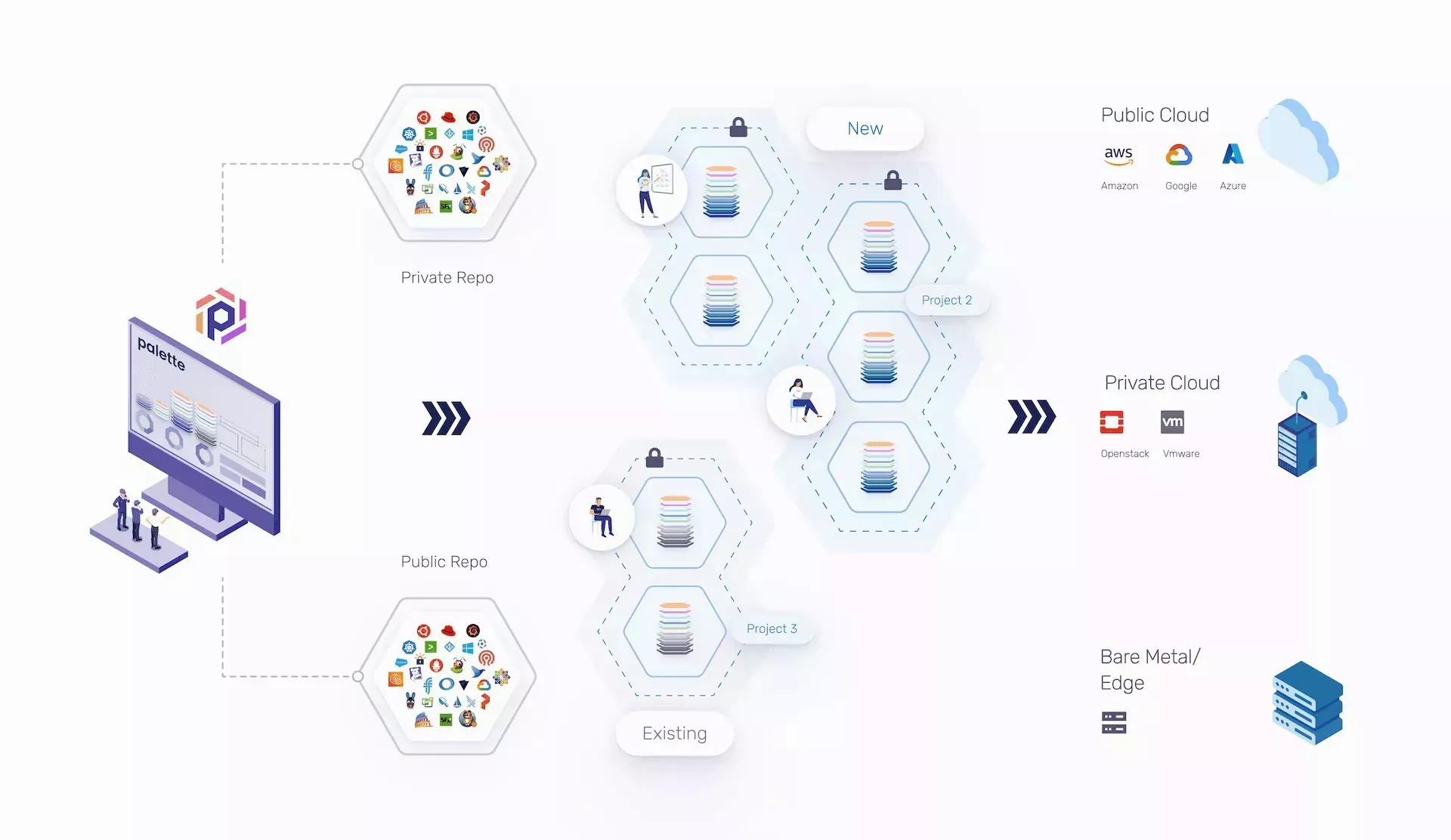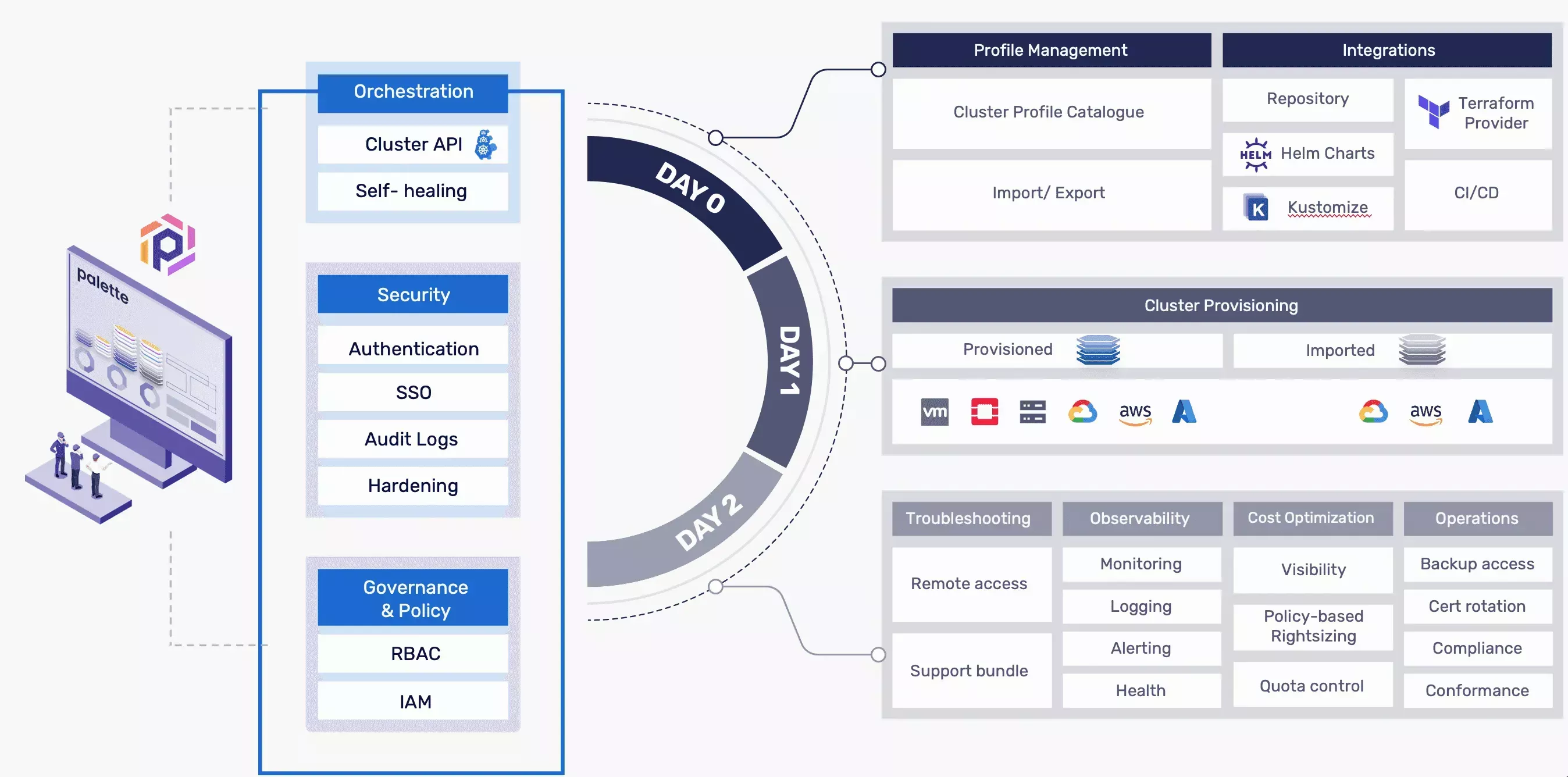What is Palette?
Palette is a complete and integrated platform that enables organizations to effectively manage the entire lifecycle of any combination of new or existing, simple or complex, small or large Kubernetes environments, whether in a data center or the cloud.
With a unique approach to managing multiple clusters, Palette gives IT teams complete control, visibility, and production-scale efficiencies to provide developers with highly curated Kubernetes stacks and tools based on their specific needs, with granular governance and enterprise-grade security.
Make sure to check out the Getting Started section to learn how you can use Palette to deploy and update your Kubernetes clusters. This section contains hands-on tutorials for Amazon Web Services (AWS), Microsoft Azure and Google Cloud Platform (GCP).

What Makes Palette Different?
Palette helps our customers accelerate and grow through Kubernetes management at scale.
Full-Stack Management
Unlike rigid and prepackaged Kubernetes solutions, Palette allows users to construct flexible stacks from OS, Kubernetes, container network interfaces (CNI), and container storage interfaces (CSI) to additional add-on application services. As a result, the entire stack - not just the infrastructure - of Kubernetes is deployed, updated, and managed as one unit, without split responsibility from virtual machines, base OS, Kubernetes infra, and add-ons.
End-to-End Declarative Lifecycle Management
Palette offers the most comprehensive profile-based management for Kubernetes. It enables teams to drive consistency, repeatability, and operational efficiency across multiple clusters in multiple environments with comprehensive day 0 - day 2 management.
Any Environment
Palette has the richest coverage in supported environments that includes:
- Public Clouds: AWS, Azure, Google Cloud and Tencent TKE. Palette supports both IaaS and managed Kubernetes services AWS EKS, Azure AKS and Google GKE.
- Data Centers: VMware, OpenStack
- Bare Metal: Canonical MAAS
- Edge
What is Under the Hood?
Palette uniquely extends and integrates the Cloud Native Computing Foundation (CNCF) open-source Cluster API project. Palette does this by providing comprehensive full-stack modeling and orchestration, governance, security, and day 0 - day 2 management capabilities.
With Palette’s Cluster Profiles, teams can define full-stack clusters that include both the Kubernetes infrastructure and any add-on application services. Cluster Profiles enable a repeatable way to deploy and reuse clusters across any environment. Palette also enables importing of existing Kubernetes environments and creating equivalent Cluster Profiles.

Who Can Benefit From Palette?
Palette provides benefits to developers and platform engineers who maintain Kubernetes environments.
Developers
Development teams will get the flexibility and freedom they are looking for to increase the speed of innovation, whether it is the cluster template with the add-on application services or choosing a Kubernetes version with integrations like logging, monitoring, and service mesh for your application development. They need not worry about Kubernetes configurations but focus on the stuff that matters.
IT Operations and SREs
Declarative management makes life easier for IT teams, with consistency, repeatability, and all the enterprise-grade controls and governance they need - especially when moving to production Cluster Profiles enable them to define and re-use full-stack clusters and support them across the entire lifecycle without having to write scripts, as well as integrate with existing tools and methodologies.
IT Executives
With an open and enterprise-grade platform, IT leaders can get peace of mind without being locked into proprietary orchestration technologies or one-size-fits-all solutions. This helps lower the total cost of ownership (TCO) and reduce operational risk.
Next Steps
Learn more about Palette and how it can improve your Kubernetes experience and those in your organization. Try Palette for free today and experience a better way of working with Kubernetes.